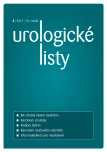-
Medical journals
- Career
Antimuscarinics and drug interaction
Authors: L. Horčička
Authors‘ workplace: GONA spol. s r. o., Urogynekologická ambulance
Published in: Urol List 2012; 10(2): 59-60
Overview
This review summarizes the aspects of metabolism, pharmacotherapy and potential drug interactions in antimuscarinic therapy, currently the most effective modality for overactive bladder syndrome treatment.
Key words:
antimuscarinics, anticholinergics, parasympatolytics, overactive bladder, urinary incontinence, drug interactio
Sources
1. Ficková D, Topinková E, Vlček J. Role P-glykoproteinového transportu v klinicky významných lékových interakcích. Remedia 2002; 12(3): 207–213.
2. Guay DRP. Clinical Pharmacokinetics of Drugs used to Treat Urge Incontinence. Clin Phamacokinet 2003; 42(14): 1243–1285.
3. Chancellor MB, De Miguel F. Tretment of overactive bladder: selective use of anticholinergic agents with low drug-druginteraction potential. Geriatrics 2007; 62(5): 15–24.
4. Krhut J. Hyperaktivní močový měchýř. Praha: Maxdorf 2007.
5. Oefelein MG. Safety and Tolerability profiles of Anticholinergic Agents Used for the Treatment of Overactive Bladder. Drug Saf 2011; 34(9): 733–754.
6. Mašata J. Anticholinergní látky v léčbě hyperaktivního močového měchýře. Remedia 2007; 17(1): 89–100.
7. Matoušková M. Solifenacin. Remedia 2009; 19(3): 170–175.
8. Verner P. Porovnání účinnosti a vedlejších účinků anticholinergik při léčbě OAB. Urologie pro praxi 2010; 11(5): 241–246.
9. Topinková E. Inkontinence jako výzva pro kvalitu péče ve stáří. Lékařské listy 2010; 18.
Labels
Paediatric urologist Urology
Article was published inUrological Journal

2012 Issue 2-
All articles in this issue
- Denosumab extends the pool of pharmacotherapy options for the management of skeletal involvement in patients with prostate cancer
- Updates on therapeutic targets and agents in castrate-resistant prostate cancer
- Upper urinary tract tumours etiology and diagnostics
- Ureteroscopic Biopsy of Upper Urinary Tract Tumors: Endoscopic and Cytologic Techniques
- Technical pearls of retroperitoneal laparoendoscopic single site nephrectomy
- Urothelial tumours of upper urinary tract chemotherapy
- Treatment of disseminated renal cancer: systemic immunotherapy, palliative treatment
- Imaging methods, their benefits to determine the extent of bladder cancer
- Treatment of muscle non-invasive tumours: transurethral resection, novel approaches
- Chemotherapy and radiotherapy of bladder cancer
- Treatment of metastatic bladder cancer, systemic chemotherapy, symptomatic treatment
- Antimuscarinics and drug interaction
- Serenoa repens extract in the treatment of benign prostatic hyperplasia
- European Association of Urology Guidelines on Vasectomy
- Urological Journal
- Journal archive
- Current issue
- Online only
- About the journal
Most read in this issue- Antimuscarinics and drug interaction
- Imaging methods, their benefits to determine the extent of bladder cancer
- Chemotherapy and radiotherapy of bladder cancer
- Upper urinary tract tumours etiology and diagnostics
Login#ADS_BOTTOM_SCRIPTS#Forgotten passwordEnter the email address that you registered with. We will send you instructions on how to set a new password.
- Career

